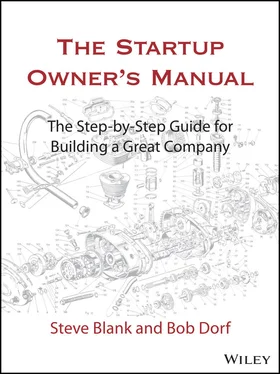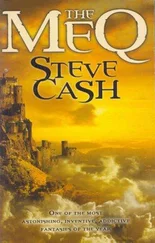Web/Mobile vs. Physical Channels
This book recognizes that Customer Development operates at different speeds for web/mobile startups versus products sold through physical distribution channels. The process to “Get/Keep/Grow” customers—the core job of any business—is different, and web products are built and obtain feedback faster. Recognizing this, we offer parallel tracks through the book: one focused on physical goods and channels, and one focused on web/mobile products and channels. Often, the book addresses them separately. When it does, we begin with the physical channel, then follow with web/mobile.
In each phase of customer discovery and validation, you’ll see diagrams like this to help you understand where you are in the process:

The upper row indicates the recommended steps for physical channel startups. The lower row depicts steps for web/mobile startups. When the steps are nearly identical, the boxes merge.
 When we’re discussing web and mobile channels, products, strategies or tactics, you’ll see the
When we’re discussing web and mobile channels, products, strategies or tactics, you’ll see the  at the start of those discussions, always in this typeface, alongside the text that shows you’ve “changed channels.”
at the start of those discussions, always in this typeface, alongside the text that shows you’ve “changed channels.”
It’s worth reading both versions of a step before turning to the one explaining “your” business type. When information in one channel is essential for startups in the other, we’ll tell you so—and tell you what to read. Web/mobile startup founders should skim the physical section before they read and begin implementing the web/mobile processes in each section.
Read the glossary in the back of the book first. Customer Development has a language all its own.
Before you dive into the details, read the Customer Development Manifesto on page 31-49.
If you are familiar with Customer Development, skim Chapters 1-3, then start with Chapter 4, “the business model hypotheses.”
If you want to align co-founders, initial employees, investors and advisors around the Customer Development philosophy, have them read Chapters 1 and 2.
If you want a high-speed overview and little more, there are two approaches:skim the checklists at the back of the book, which will give you a sense of all the tasks you must complete to implement Customer Development; orflip through the book, looking for “jumbo quotes” like this:This book is not a novel… It’s a reference manual.
These quotes highlight the 100 or so “big ideas” found throughout the book and offer a “CliffsNotes” or “Twitter” sense of the nearly 600 pages of text.
If you want a detailed checklist of the things founders need to get right, start with Chapter 4, “the business model hypothesis,” and use the checklists in Appendix A page 469.
If your startup is well under way, you might want to start at Chapter 7, “Pivot or Proceed,” to gauge your progress. Then you can jump to Chapter 12, “Metrics that Matter,” to see if you’re ready to scale.
To develop and test a web/mobile minimum viable product (MVP), read: Design Tests (page 191), Build Your Low Fidelity MVP (page 200), Low Fidelity MVP Problem Test (page 211), and Optimize Getting More Customers (page 380).
To develop and test a physical minimum viable product (MVP), read: Customer Contacts (page 195), Problem Understanding (page 203), Customer Understanding (page 218), and The Sales Roadmap (page 344).
To focus on web/mobile marketing (how to “get,” “keep” and “grow” customers), read:Hypotheses: Customer Source/Wiring (page 93), Channels (page 104), and Customer Relationships (page 144).Build Your Low Fidelity MVP (page 200), Low Fidelity MVP Problem Test (page 211), Traffic/Competitive Analysis (page 225), High Fidelity MVP Test (page 237), and Measure Customer Behavior (page 245).Get Ready to Sell: Craft Positioning Statement (page 293), Acquire/Activate Customers Plan (page 304), Create a High Fidelity MVP (page 330), Build a Metrics Tool Set (page 338), and Hire a Data Analytics Chief (page 350).Get Out of the Building: Prepare Optimization Plans/Tools (page 362), Optimize Getting More Customers (page 380), Optimize “Keep” and “Grow” (page 396), Test Sell Traffic Partners (page 409).
To focus on physical channel sales and marketing (how to “get”, “keep” and “grow” customers), read:Hypotheses: Customer Segments Who/Problem (page 85), Channels (page 98), Customer Relationships (page 144), and Revenue Stream Pricing (page 180).Prepare for Customer Contacts (page 195), Problem Understanding (page 203), Market Knowledge (page 222), Create Product Presentation (page 235), and Test Solution with Customer (page 239).Get Out of the Building: Create Sales and Collateral Materials (page 296), Hire Sales Closer (page 329), Sales Channel Roadmap (page 332), and Develop the Sales Roadmap (page 344).
Educators who want to teach Customer Development or the experiential Lean LaunchPad class should read:Our website, www.steveblank.com, with links to our syllabi used at Stanford, Berkeley and the National Science Foundation.Before the class meets, have the students read:—The Customer Development Manifesto in Chapter 2—An Introduction to Customer Development in Chapter 2Each week’s lectures are organized around each of the individual hypotheses in Phase 1, pages 69-188.For the Lean LaunchPad class, have students read:—Get Out of the Building and Test the Problem in Chapter 5, pages 189-226.—Get Out of the Building and Test the Product Solution in Chapter 6, pages 227-256.All classes should read:—Pivot or Proceed, in Chapter 7, pages 270-273.—Metrics that Matter, in Chapter 12, pages 438-459.
We see a direct correlation between the entrepreneurs’ success and the degree to which their copy is dog-eared, beat up and tattered. USE the book, don’t just read it!
We see a direct correlation between the entrepreneurs’ success and the degree to which their copy is dog-eared, beat up and tattered.
Use the checklists . There are more than 40 at the back of the book—one for every step.
Don’t read too much at a time. This is a reference manual. It’s exhausting when read as a book. Take “small bites” of a few sections at a time, at most. Dog-ear it and use Post-it notes to mark your place, and keep the book close at hand so you can refer to it often.
Scan ahead. It gives you context for what you are currently doing. If you’re starting work on Chapter 4, for example, quickly scan Chapter 5 first so you understand how what you’re doing now supports what comes next.
For a helpful online tool to monitor your team’s progressin the Customer Development process, visit
http://www.zoomstra.com/foundersworkbook/
Entrepreneurship is not a cookbook or a checklist . At the end of the day, founders are artists. Don’t expect everything to work like the book. It’s impossible for this book to address every entrepreneurial decision and every type of startup. You’re outside the building not only looking for facts, but for insight and inspiration. Not every piece of advice fits every situation you’ll encounter. And not every piece of advice will always work. That’s what entrepreneurs are for.
IN 1602, THE DUTCH EAST INDIA COMPANY, generally regarded as the first “modern company,” issued the first stock certificates. In the intervening 300 years, companies managed to start, build and grow without formally trained executives. By the 20 thcentury, the complexity of modern corporations demanded a cadre of executives trained to administer large companies. In 1908, Harvard awarded the first master of business administration (MBA) degree to fill the need to bring professional education standards to big business. The MBA curriculum standardized and codified the essential elements an operating executive in a modern company needed to know: cost accounting, strategy, finance, product management, engineering, personnel management and operations.
Читать дальше


 When we’re discussing web and mobile channels, products, strategies or tactics, you’ll see the
When we’re discussing web and mobile channels, products, strategies or tactics, you’ll see the 









